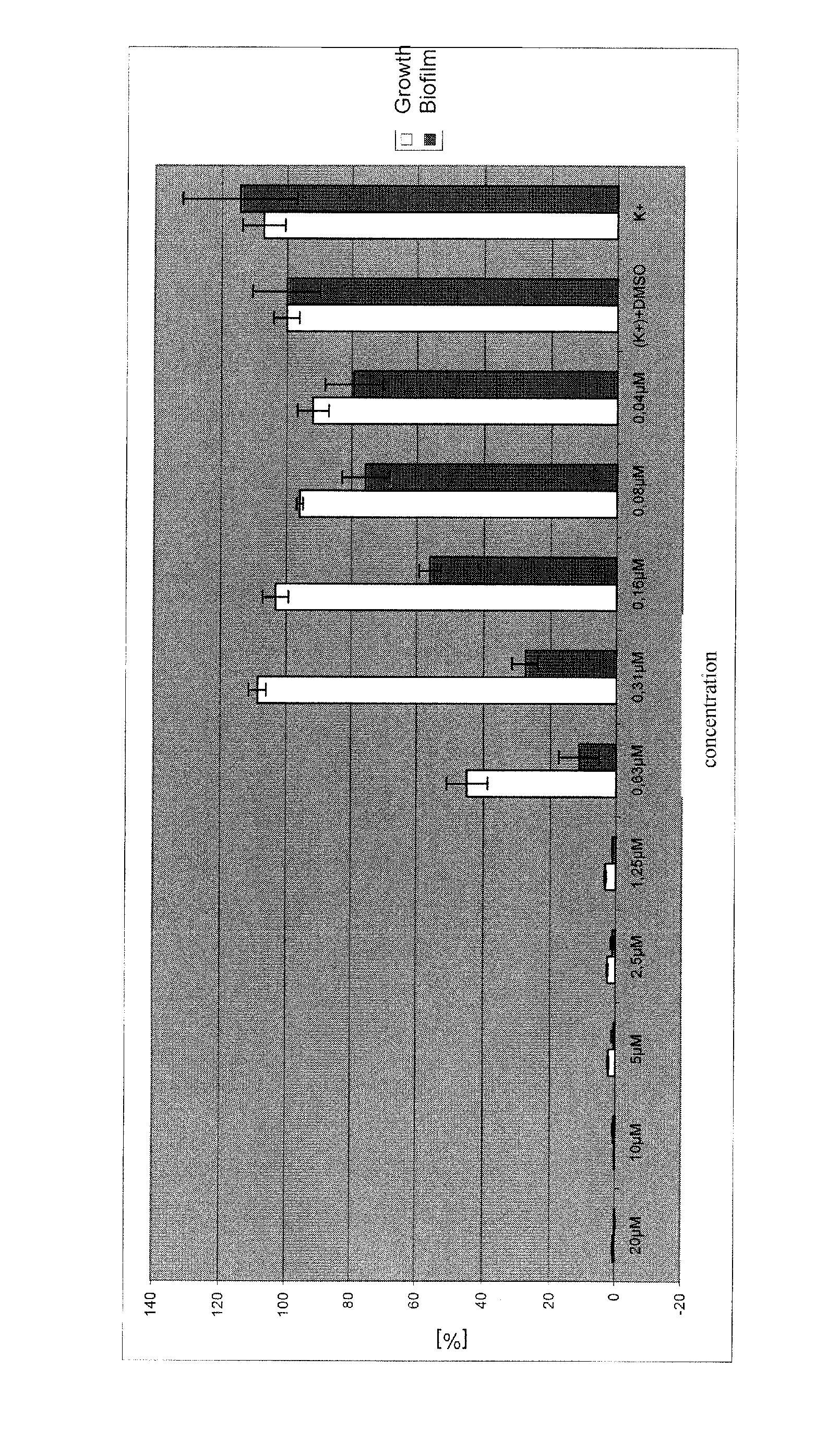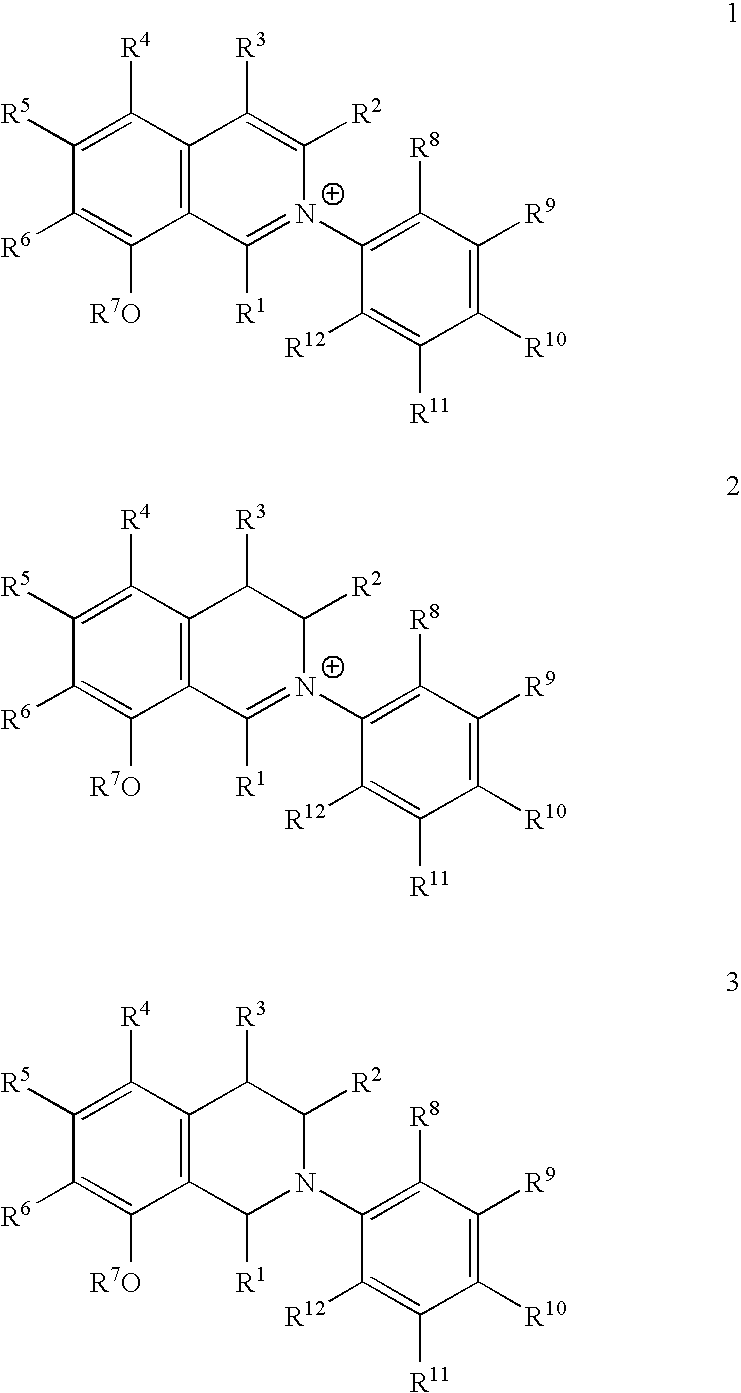Biofilm-inhibiting effect and anti-infective activity of N,C-linked aryl isoquinolines and the use thereof
a technology of aryl isoquinoline and c-linked isoquinoline, which is applied in the field of biofilm inhibition effect and anti-infective activity of n, c-linked isoquinoline, can solve the problems of large biofilm formation problem, drastic increase of water drag, and essential economic damage in shipping, and achieve excellent anti-l effect and good and particularly selective
- Summary
- Abstract
- Description
- Claims
- Application Information
AI Technical Summary
Benefits of technology
Problems solved by technology
Method used
Image
Examples
example 2
Synthesis of the Dihydro Isoquinolinium-Salt 2a
Production of the Secondary Amine (S)-8
[0032]
[0033]272 mg (2.55 mmol) of 2,6-lutidine were added to a suspension consisting of 658 mg (3.83 mmol) of 1-naphthyl boric acid (7), 0.926 mg (0.005 mmol) copper(II) acetate, and 1.14 mg myristic acid in 5 ml absolutized toluene. After 5 minutes, 500 mg (2.55 mmol) of primary amine 6 (produced according to G. Bringmann, R. Weirich, H. Reuscher, J. R. Jansen, L. Kinzinger, T. Ortmann Liebigs Ann. Chem. 1993, 877-888) were added, and the reaction mix was stirred for 30 hours in an oxygen atmosphere at room temperature. Subsequently, the suspension was diluted with 10 ml acetic ethyl ester, and filtered through silica (acetic ethyl ester). The solvent was removed in vacuo, and the product was purified using column chromatography (silica, petrolether:ethyl acetate=10:1). The secondary amine 8 was obtained as a brown oil.
(2R)—N-(1-naphthyl)-1-(3′,5′-dimethoxyphenyl)-2-aminopropane (S)-8
[0034]Yield: ...
example 3
Synthesis of the Tetrahydro Isoquinoline 3a
[0060]
[0061]57.2 mg (0.151 mmol) of NaBH4 were added in portions at 0° C. to a solution of 56.0 mg (0.126 mmol) of the isoquinolinium-perchlorate 1b in 14 ml methanol. After stirring of the reaction mix at room temperature for 1 hour, 5 ml water were added, and the stirring continued for a further 12 hours. The suspension was then spiked with half-concentrated hydrochloric acid, and the product was extracted with diethylether. The etheric phases were pooled, dried with MgSO4, and the solvent removed in vacuo. The oily residue was purified on silica using column chromatography (hexane:ethyl acetate 1:2). The naphthyl tetrahydro isoquinoline 3a was obtained as white solid.
N-(1-naphthyl)-6,8-dimethoxy-1,3-(cis)-dimethyl tetrahydro isoquinoline 3a
[0062]Yield: 30.0 mg (0.103 mmol; 68%).
[0063]Melting point: 69° C. (hexane:ethyl acetate)
[0064]IR (KBr): {tilde over (ν)}=3432 (br), 3043 (s), 2990 (s), 2926 (s), 2835 (m), 1687 (m), 1608 (s), 1490 (w)...
example 4
Biological Activities
1. Effect Against Parasites of the Genus Leishmania
[0069]Leishmania major-promastigotes (MHOM / IL81 / FE / BNI) were cultivated in blood agar-cultures at 26° C., 5% CO2, and 95% humidity. For the experiment, the promastigotes were washed twice with saline phosphate buffer (PBS) and subsequently suspended (108 cells / ml) in Click-RPMI-1640-medium without phenol red, spiked with 10% FCS, 2 mM L-glutamine, 1.0 mM HEPES-buffer, pH 7.2, 100 μg / ml penicillin, 160 mg / ml gentamycin, 7.5% NaHCO3 and 50 μM 2-mercaptoethanol (culture medium). For the determination of activity, 200 μl of the promastigote-suspension in microtiter plates were each incubated with the compounds in a geometric series of dilutions for 24 hours at 26° C., 5% CO2, and 95% humidity. Subsequently, 20 μl Alamar Blue (Trinova Biochem, Gieβen, Germany) were added to each of the microcultures, and the cultures were incubated further. Cultures that only contained medium and the compound, or only cellular suspe...
PUM
| Property | Measurement | Unit |
|---|---|---|
| humidity | aaaaa | aaaaa |
| humidity | aaaaa | aaaaa |
| pH | aaaaa | aaaaa |
Abstract
Description
Claims
Application Information
 Login to View More
Login to View More - R&D
- Intellectual Property
- Life Sciences
- Materials
- Tech Scout
- Unparalleled Data Quality
- Higher Quality Content
- 60% Fewer Hallucinations
Browse by: Latest US Patents, China's latest patents, Technical Efficacy Thesaurus, Application Domain, Technology Topic, Popular Technical Reports.
© 2025 PatSnap. All rights reserved.Legal|Privacy policy|Modern Slavery Act Transparency Statement|Sitemap|About US| Contact US: help@patsnap.com



